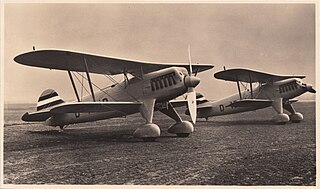
The Heinkel He 51 was a German single-seat biplane which was produced in a number of different versions. It was initially developed as a fighter; a seaplane variant and a ground-attack version were also developed. It was a development of the earlier He 49.
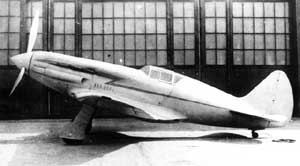
The Mikoyan-Gurevich MiG-1 was a Soviet fighter aircraft of World War II that was designed to meet a requirement for a high-altitude fighter issued in 1939. To minimize demand on strategic materials such as aluminum, the aircraft was mostly constructed from steel tubing and wood. Flight testing revealed a number of deficiencies, but it was ordered into production before they could be fixed. Although difficult to handle, one hundred were built before the design was modified into the MiG-3. The aircraft was issued to fighter regiments of the Soviet Air Forces (VVS) in 1941, but most were apparently destroyed during the opening days of Operation Barbarossa, the German invasion of the Soviet Union in June 1941.
Grigorovich was a Soviet aircraft design bureau, headed by Dmitry Pavlovich Grigorovich.
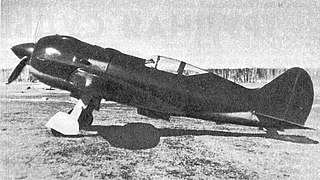
The Polikarpov I-185 was a Soviet fighter aircraft designed in 1940. It was flown with three engines but all of them were either insufficiently developed for service use or their full production was reserved for other fighters already in production. The I-185 program was cancelled on 27 January 1943.
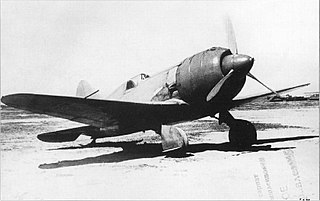
The Polikarpov I-180 was a 1938 Soviet fighter prototype. It was the last attempt to extract performance from the basic Polikarpov I-16 design. The development cycle was plagued with problems, especially with the death of the star Soviet test pilot Valery Chkalov in one of the prototypes.
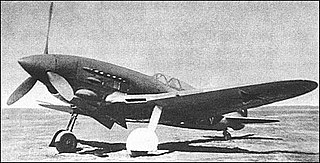
The Polikarpov ITP was a Soviet fighter prototype designed during World War II. Development was prolonged by the evacuation of the design bureau forced by the German advance on Moscow in the fall of 1941. By the time the second prototype was finished the Soviets had fighters with equivalent or better performance already in production and the program was cancelled.

The Polikarpov I-153 Chaika was a late 1930s Soviet biplane fighter. Developed as an advanced version of the I-15 with a retractable undercarriage, the I-153 fought in the Soviet-Japanese combats in Mongolia and was one of the Soviets' major fighter types in the early years of the Second World War. Three I-153s are still flying.

The Polikarpov I-5 was a single-seat biplane which became the primary Soviet fighter between its introduction in 1931 through 1936, after which it became the standard advanced trainer. Following Operation Barbarossa, which destroyed much of the Soviet Air Forces (VVS), surviving I-5s were equipped with four machine guns and bomb racks and pressed into service as light ground-attack aircraft and night bombers in 1941. They were retired in early 1942 as Soviet aircraft production began to recover and modern ground-attack aircraft like the Ilyushin Il-2 became available. A total of 803 built.

The Fiat CR.1 was an Italian biplane fighter aircraft of the 1920s. Of wood-and-fabric construction, it was designed by Celestino Rosatelli, from whom it gained the 'CR' designation. Its most distinctive feature was that the lower wings were longer than the upper ones.

The Bartel BM 6 was a Polish biplane trainer fighter aircraft of 1930. It did not advance beyond the prototype stage.
The Blériot-SPAD S.81 was a French fighter aircraft developed in 1923 to a requirement by the French Air Force. It was flown competitively against the Dewoitine D.1 and was selected over that aircraft due to the Dewoitine's more radical design, leading to an order for 80 aircraft. The S.81 was a single-bay biplane of conventional configuration with I-shaped interplane struts and lacking Herbemont's usual swept upper wing. It featured a wooden fuselage of monocoque construction and metal wings skinned in fabric. Production versions differed from the prototypes in having a lengthened fuselage and larger tail fin.
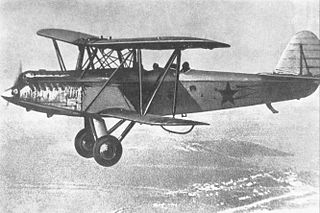
The Polikarpov R-5 was a Soviet reconnaissance bomber aircraft of the 1930s. It was the standard light bomber and reconnaissance aircraft of the Soviet Air Force for much of the 1930s, while also being used heavily as a civilian light transport, some 7,000 being built in total.

The Polikarpov I-1 was the first indigenous Soviet monoplane fighter. It had to be redesigned after the crash of the first prototype, and was eventually ordered into production in small numbers, but it was never accepted for service with the Soviet Air Forces.

The Polikarpov I-3 was a Soviet fighter designed during the late 1920s. It entered service in 1929, but was retired in 1935 with the advent of fighters with higher performance.

The Polikarpov I-6 was a Soviet biplane fighter prototype of the late 1920s. It was designed with traditional wooden construction in comparison with the wood and steel tube construction Polikarpov I-5. Its development took longer than planned and the lead designer, Nikolai Polikarpov, was arrested for industrial sabotage, which only further delayed the project. Only two prototypes were built, as the I-5 was selected for production.

Polikarpov DI-1, also known as 2I-N1, Russian: Поликарпов ДИ-1 (2И-Н1), was a prototype Soviet two-seat fighter designed during the 1920s. The sole prototype built crashed on its ninth flight, due to manufacturing defects, and the program was cancelled.

Grigorovich DI-3, , was a prototype two-seat fighter developed in the Soviet Union in the 1930s. It was intended to be a long-range escort fighter developed from the DI-2 with improved range and performance comparable to single-seat fighter aircraft of the time. DI-3 was a single-bay biplane of mixed construction with a twin-rudder tailplane of variable incidence. Although initial tests demonstrated flight characteristics comparable to Polikarpov I-5, the addition of armament and operational equipment caused significant degradation in performance and DI-3 did not enter mass production. The prototype was subsequently fitted with an enclosed cockpit and used as a VIP transport.
The Nikitin-Schyevchyenko IS series,, were single seat polymorphic fighters designed and produced in the USSR from 1938.

The Polikarpov TIS was a heavily armed Soviet heavy fighter designed during the early 1940s. Competing contemporaneous designs in the USSR included the Grushin Gr-1, Mikoyan-Gurevich DIS and Tairov Ta-3.

The Tupolev I-14 was a Soviet fighter aircraft of the 1930s. It was a single-engined, single-seat monoplane with retractable undercarriage, designed to carry heavy armament, and as such was one of the most advanced fighters of its time. It was ordered into production, but this was cancelled after only a small number had been built, the competing Polikarpov I-16 being preferred.
















